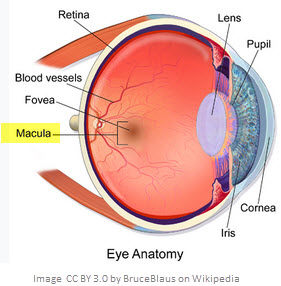Stargardt disease
 This activity provides a great opportunity for students to make links between the Cells, Molecules and Genetics topics of the IB course. Perfect preparation for difficult exam questions. Stargardt disease is an inherited disorder of the retina – the layer of the eye that senses light. It is an inherited condition caused by a mutation in a single gene. This mutation results prevents the synthesis of a protein which is important in the vitamin A cycle. This is a metabolic process which takes place across two layers of specialized cells in the retina of the eye. A build up of a fatty deposit leads to the death of cells and blindness.
This activity provides a great opportunity for students to make links between the Cells, Molecules and Genetics topics of the IB course. Perfect preparation for difficult exam questions. Stargardt disease is an inherited disorder of the retina – the layer of the eye that senses light. It is an inherited condition caused by a mutation in a single gene. This mutation results prevents the synthesis of a protein which is important in the vitamin A cycle. This is a metabolic process which takes place across two layers of specialized cells in the retina of the eye. A build up of a fatty deposit leads to the death of cells and blindness.
Lesson Description
G uiding Questions
uiding Questions
- Stem cells are often seen as a potential solution to genetic diseases caused by single gene mutations.
- Apart from Stargardt disease, name two other conditions caused by gene mutations.
- What help could stem cells be in each case?
Activity 1 - Stargardt disease and stem cells
Watch the short video about Ashley who has stargardts disease
![]() Stargardts disesase new treatment
Stargardts disesase new treatment
Viewpoints
What do you think these people in Ashley's life will be thinking or asking about Ashley's eyes?

Brainstorm different perspectives, structure your answers like this;
I'm thinking of Stargardts disease from the viewpoint of .................. ...; I'd like to know ......................... ?
Research
Watch the video ![]() What is stargardt disease? and the summary of
What is stargardt disease? and the summary of ![]() Treatment for Stargardt from the WSJ.
Treatment for Stargardt from the WSJ.
Record answers to as many of your questions as you can.
Questions
Which cells are affected by Stargardt disease?
.............................................................................................................
What types of biological molecules are implicated?
.............................................................................................................
What type fo inheritance causes Stargardt disease?
.............................................................................................................
Suggested answers
click the eye icon to display answers
Which cells are affected by Stargardt disease?
Retina cells (Rods and Cones) and a layer of cells in the retina called RPE cells
What types of biological molecules are implicated?
A Protein and a lipid which builds up in the RPE cells
What type fo inheritance causes Stargardt disease?
Simple monohybrid inheritance of a recessive allele.
Activity 2 - Stargardt disease IB style questions
This topic could lead to questions on any of the topics mentioned, Cells, Molecules and Genetics.
Answer the questions on ![]() this Stargardt linking questions worksheet shown below.
this Stargardt linking questions worksheet shown below.
Activity 3 - Mapping links between connected topics
IB exam questions often make links between topics. If you really understand the Biology then these links are easy to follow. It takes a little practice to break away from your revision notes separated into topics.
Linking topics
The mindmap below shows one way to make the IB Biology links to the subject of Stargarts disease.
Use this as a starting point to draw your own mind map and to attach the information you have learned to the ends of each branch.

Teacher's notes
Stargadts disease is mentioned in the IB Biology guide in relation to stem cells, but there is no reason why this might not be used for a question on genetics or even for a data based question on membrane transport. The names of the cell types involved are not required, except in Option A which includes the eye. In this activity it is assumed that students have no knowledge of the eye.
Activity 1 aims to catch the students' interest in the disease, after all it is the greates cause of blindness in young people. The videos and the questions support applications from the cells topic.
Activity 2 takes this knowledge and gives students a range of questions which cover varying parts of the course. For this reason it would be best to do these questions after the theoretical genetics topic. However the worksheet has been set out so that the teacher can choose which sections of questions to include.
There are some model answers here: stargarts disease model answers. Access to this page can be controlled using the options in the student access area.
Activity 3 gives students a chance to reflect on the topics which they have learned and to make connections between them. This is likely to help to consolidate their understanding and to prepare them for links in IB exam questions.
Extention idea
A more detailed but great video about stem cells could make an extension task.
Difficult reading - biology research papers
http://www.molvis.org/molvis/v12/a102/v12a102-valverde.pdf

 IB Docs (2) Team
IB Docs (2) Team
